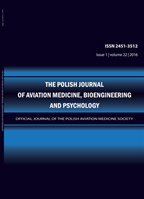2018, Volume 24, Issue 2
APPLICATION OF HUMAN CENTRIFUGE TO SIMULATE PARABOLIC FLIGHT: EARLY EXPERIENCE
KRZYSZTOF KOWALCZUK1, STEFAN GAŹDZIŃSKI2, MARIUSZ WALAS1, MARCIN STROJEK1, MICHAŁ JANEWICZ1, TADEUSZ GRZESZUK1, KJETIL WORMNES3, ANDREAS WERNER4
-------------------------------------------------------------------------------------------------
1Department of Simulator Studies and Aeromedical Training, Military Institute of Aviation Medicine
2Creative Neuroscience Lab – CNS Lab, Military Institute of Aviation Medicine
3European Space Agency
4Aviation Physiology Diagnostics and Research, German Air Force – Centre of Aerospace Medicine
Autor korenspondencyjny: KRZYSZTOF KOWALCZUK; Department of Simulator Studies and Aeromedical Training, Military Institute of Aviation Medicine; email: kkowalczuk@wiml.waw.pl
Full text
Streszczenie
Introduction: We have used our human centrifuge to simulate the parabolic flight environment. Tests were carried out on four candidates taking part in a parabolic flight program. The main idea behind the project was to test the possibility of simulation of a near zero Gz environment with the centrifuge as a cheaper and simpler alternative to parabolic flight. An additional goal was to try to identify crew members who would present excessive symptoms of motion sickness.
Methods: The flight profile was adjusted to replicate the characteristic conditions and specificity of a parabolic flight. The study was performed as a practical test in a variable acceleration environment similar to a real parabolic flight (with G-limits: max. +2 Gz, min.0 Gz, and up to 13 repetitions of a cycle). Evaluation of eye-hand coordination, orientation and Romberg tests were performed. Each candidate was monitored (HR, ECG, SaO2, earpulse). The exposure was performed twice on two consecutive days.
Results: All participants completed the expositions with positive outcomes. They reported that they had the illusion of microgravity. They exhibited similar hand-eye coordination issues as in microgravity. Last but not least, with repeated exposures, the average heart rates were decreasing, pointing to adaptation to the procedure. Trained behaviors and organism reactions have been successfully used and verified afterwards during the real parabolic flight organized by the ESA.
Conclusions: Despite the preliminary nature of the study, promising results were obtained, which may be further developed and ultimately used to improve the quality and effectiveness, especially the cost effectiveness, of ground preparation of astronauts for microgravity. Furthermore, the profile might be adjusted to evaluate experiments involving the use of neuroimaging techniques in space.
Słowa kluczowe
human centrifuge, parabolic flight, micro-gravity, simulation, adaptation
